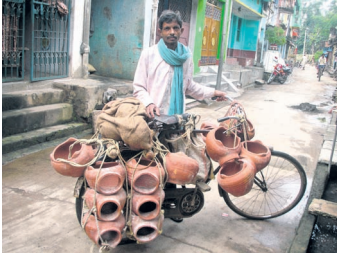Khandapada: The humble potter’s wheel, once a symbol of self-reliance and cultural pride, now turns in despair. In villages across Nayagarh, the potter community is watching its centuries-old craft crumble as earthenware loses ground to plastic and steel. What was once a dignified livelihood has become a fight for survival for many artisans.
For generations, households relied on clay vessels—pitchers for water, urns for rituals, and pots for cooking. Potters (kumbhakaras) shaped earth into life’s essentials and were indispensable during festivals, weddings, and even funerals. But in today’s age of steel and plastic, the demand for clay pots has fallen drastically, leaving potters struggling to sell even a handful of pots. The process of preparing earthenware is laborious.
Potters first collect suitable clay, soak it in water for a day, and then knead it to remove stones and impurities. The prepared clay is shaped into lumps and placed on the spinning wheel, where artisans carefully mould items. The half-made wares are dried in shade for hours, beaten into proper shape, and then fired in kilns called ‘uha’.
Also Read: Potters have a field day as demand rockets for diyas
The firing technique is critical as improper temperature or environment can ruin the entire batch. Depending on the fuel, firing may take three to eight hours, and the colour of the pottery changes accordingly. Once ready, transporting the fragile wares poses another challenge. Potters usually carry them on their heads, bicycles, or by hand rather than using motor vehicles. Despite their toil, the meagre returns hardly match the effort.
Veteran potters like Pabi Muduli, 50, and Gobardhan Muduli, 68, of Benagadia, lament the loss of respect and demand for their products.
“In our childhood, we took pride in this profession. Now, in the era of plastic and steel, hardly anyone is interested in clay pots. Carrying 15 to 20 pots yields so little that it does not even cover our labour,” they said.
Some artisans have found partial relief through terracotta work.
Potters such as Pavitra Mohan Muduli, 56, and Gobardhan Muduli, 45, who received training from the state Handicrafts Directorate in 1991, now make decorative terracotta items and sell them at fairs in Cuttack’s Bali Jatra, Puri, Bhubaneswar, Dhenkanal, and Angul. These products fetch better prices, though government schemes have fallen short in providing equipment and support to improve quality.
In Benagadia, 42 households belong to the potter community, while Tentuliapalli has 25 and Jogiapalli 20 to 25. Yet only 20 to 25 families across these villages remain active in the craft.
For many, pottery has been both livelihood and tradition handed down through generations. From cooking pots to ritual vessels and terracotta art, they mould everything by hand.
However, rising costs of firewood, government restrictions on its collection and water scarcity in summer have further strained the profession. “Half the family works in pottery, but the earnings are never enough. Still, we cannot abandon our ancestral craft,” said artisans
Lingaraj Muduli, 62, Bhobei Muduli, 65, and Maheshwar Muduli, 70. Others, such as Kartik Mudul,i note that younger generations prefer wage labour outside the village, finding no future in pottery. Potters argue that unless the government steps in with concrete measures such as affordable raw materials, modern equipment, and market linkages, the centuries-old craft may vanish altogether.
PNN
